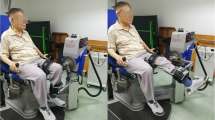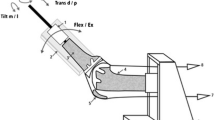Abstract
Purpose
Decreased quadriceps strength and fatigue is suspected to be one of the contributing factors for anterior knee pain and malfunction after total knee arthroplasty (TKA). The purpose of this in vitro study was to investigate the amount of quadriceps force required to extend the knee isokinetically after TKA in dependence of different prosthesis designs and the state of the posterior cruciate ligament (PCL).
Materials and methods
Eight fresh frozen human knee specimens underwent testing in a kinematic device simulating an isokinetic knee extension cycle from 120° of flexion to full extension. The quadriceps force was measured after implantation of a cruciate retaining (CR) TKA (Genesis II, Smith&Nephew, Memphis, TN, USA) applying a conventional CR (11 mm) and a highly conforming (deep dished, DD) polyethylene (PE) inlay consecutively before and after resection of the PCL. Finally, tests were repeated with a posterior-stabilized (PS) design.
Results
Simulating a physiological knee extension, no significant differences in the average quadriceps force were detected between the cruciate preserving inlays (CR 1,146.57 ± 88.04 N, DD 1,150.19 ± 97.54 N, P = 0.86) as long as the PCL was intact. After resection of the PCL, the required quadriceps force increased significantly for both designs (CR 1,203.17 ± 91.51 N, P < 0.01 and DD 1,191.88 ± 80.07 N, P < 0.03). After implantation of the posterior stabilized femoral component quad force decreased to its initial levels with forces significantly lower compared to the PCL deficient knees provided with a CR or DD (PS 1,130.91 ± 107.88 N, P < 0.01) inlay. With a deficient PCL there were no statistical differences for the DD design in comparison with CR in mean quad forces (CR 1,203.17 ± 91.51 N vs. DD 1,191.88 ± 80.07 N, P = 0.50) nor in peak forces (CR 1,729.44 ± 161.86 N, DD 1,688.66 ± 123.18 N, P = 0.17).
Discussion
At intact PCL peak quad forces and mean forces beyond 70° of flexion could be shown to be significantly lower with a PS TKA design in comparison with cruciate preserving designs such as CR and DD. In the PCL deficient knee quad forces with a highly conforming implant (DD) and CR were significantly higher than with a PS TKA. The use of PS implants in all PCL deficient knees seems to be advisable.




Similar content being viewed by others
Abbreviations
- ACL:
-
Anterior cruciate ligament
- ap:
-
Anteroposterior
- CR:
-
Cruciate retaining
- DD:
-
Deep dished
- EF:
-
Extension/flexion
- Hz:
-
Hertz
- ml:
-
Mediolateral
- N:
-
Newton
- Nm:
-
Newton metre
- PCL:
-
Posterior cruciate ligament
- PS:
-
Posterior stabilized
- TKA:
-
Total knee arthroplasty
References
Andriacchi TP, Galante JO, Fermier RW (1982) The influence of total knee-replacement design on walking and stair-climbing. J Bone Joint Surg Am 64(9):1328–1335
Rand JA (1994) The patellofemoral joint in total knee arthroplasty. J Bone Joint Surg Am 76(4):612–620
Lynch AF, Rorabeck CH, Bourne RB (1987) Extensor mechanism complications following total knee arthroplasty. J Arthroplasty 2(2):135–140. doi:10.1016/S0883-5403(87)80020-7
Boyd AD Jr, Ewald FC, Thomas WH, Poss R, Sledge CB (1993) Long-term complications after total knee arthroplasty with or without resurfacing of the patella. J Bone Joint Surg Am 75(5):674–681
Elias JJ, Bratton DR, Weinstein DM, Cosgarea AJ (2006) Comparing two estimations of the quadriceps force distribution for use during patellofemoral simulation. J Biomech 39(5):865–872. doi:10.1016/j.jbiomech.2005.01.030
Kaufer H (1971) Mechanical function of the patella. J Bone Joint Surg Am 53(8):1551–1560
Dennis DA, Komistek RD, Mahfouz MR, Haas BD, Stiehl JB (2003) Multicenter determination of in vivo kinematics after total knee arthroplasty. Clin Orthop Relat Res Nov(416):37–57
Dennis DA, Komistek RD, Colwell CE, Jr., Ranawat CS, Scott RD, Thornhill TS, Lapp MA (1998) In vivo anteroposterior femorotibial translation of total knee arthroplasty: a multicenter analysis. Clin Orthop Relat Res Nov(356):47–57
Berman AT, Bosacco SJ, Israelite C (1991) Evaluation of total knee arthroplasty using isokinetic testing. Clin Orthop Relat Res Oct(271):106–113
Ostermeier S, Hurschler C, Stukenborg-Colsman C (2004) Quadriceps function after TKA—an in vitro study in a knee kinematic simulator. Clin Biomech (Bristol, Avon) 19(3):270–276
Stukenborg-Colsman C, Ostermeier S, Hurschler C, Wirth CJ (2002) Tibiofemoral contact stress after total knee arthroplasty: comparison of fixed and mobile-bearing inlay designs. Acta Orthop Scand 73(6):638–646
Stukenborg-Colsman C, Ostermeier S, Wenger KH, Wirth CJ (2002) Relative motion of a mobile bearing inlay after total knee arthroplasty—dynamic in vitro study. Clin Biomech (Bristol, Avon) 17(1):49–55
Laskin RS, Maruyama Y, Villaneuva M, Bourne R (2000) Deep-dish congruent tibial component use in total knee arthroplasty: a randomized prospective study. Clin Orthop Relat Res Nov(380):36–44
Fuchs S, Tibesku CO, Jerosch J (1998) Isokinetic measurements in total knee arthroplasty patients compared to healthy volunteers. In: 8th Congress of the European Society of Sports Traumatology, Knee Surgery and Arthroscopy, 1998, Nice, France
Huberti HH, Hayes WC, Stone JL, Shybut GT (1984) Force ratios in the quadriceps tendon and ligamentum patellae. J Orthop Res 2(1):49–54. doi:10.1002/jor.1100020108
Ostermeier S, Friesecke C, Fricke S, Hurschler C, Stukenborg-Colsman C (2008) Quadriceps force during knee extension after non-hinged and hinged TKA: An in vitro study. Acta Orthop 79(1):34–38
Ostermeier S, Hurschler C, Windhagen H, Stukenborg-Colsman C (2006) In vitro investigation of the influence of tibial slope on quadriceps extension force after total knee arthroplasty. Knee Surg Sports Traumatol Arthrosc 14(10):934–939
Nisell R (1985) Mechanics of the knee. A study of joint and muscle load with clinical applications. Acta Orthop Scand Suppl 216:1–42
Hollister AM, Jatana S, Singh AK, Sullivan WW, Lupichuk AG (1993) The axes of rotation of the knee. Clin Orthop Relat Res May(290):259–268
Komistek RD, Mahfouz MR, Bertin KC, Rosenberg A, Kennedy W (2008) In vivo determination of total knee arthroplasty kinematics: a multicenter analysis of an asymmetrical posterior cruciate retaining total knee arthroplasty. J Arthroplasty 23(1):41–50
Insall JN, Lachiewicz PF, Burstein AH (1982) The posterior stabilized condylar prosthesis: a modification of the total condylar design. Two to four-year clinical experience. J Bone Joint Surg Am 64(9):1317–1323
Dennis DA, Komistek RD, Mahfouz MR (2003) In vivo fluoroscopic analysis of fixed-bearing total knee replacements. Clin Orthop Relat Res May(410):114–130
Banks SA, Hodge WA (2004) Implant design affects knee arthroplasty kinematics during stair-stepping. Clin Orthop Relat Res Sep(426):187–193
Scott RD, Thornhill TS (1994) Posterior cruciate supplementing total knee replacement using conforming inserts and cruciate recession. Effect on range of motion and radiolucent lines. Clin Orthop Relat Res Dec(309):146–149
Conflict of interest statement
All authors disclose any financial and personal relationships with other people or organisations that could inappropriately influence the presented work.
Author information
Authors and Affiliations
Corresponding author
Rights and permissions
About this article
Cite this article
Heyse, T.J., Becher, C., Kron, N. et al. Quadriceps force in relation of intrinsic anteroposterior stability of TKA design. Arch Orthop Trauma Surg 130, 1–9 (2010). https://doi.org/10.1007/s00402-009-0927-4
Received:
Published:
Issue Date:
DOI: https://doi.org/10.1007/s00402-009-0927-4




